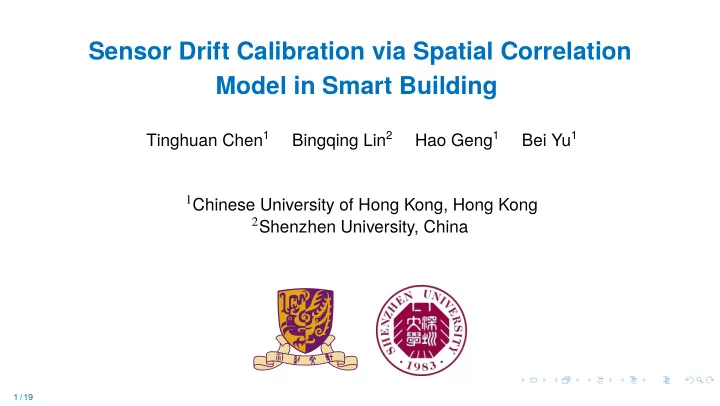

Sensor Drift Calibration via Spatial Correlation Model in Smart Building Tinghuan Chen 1 Bingqing Lin 2 Hao Geng 1 Bei Yu 1 1 Chinese University of Hong Kong, Hong Kong 2 Shenzhen University, China 1 / 19
Smart Building and Cyber-Physical System Sensor Data Center 2 / 19
Temperature Sensor ◮ Errors exist in senor output; ◮ Manufacturing defect, noise, aging... ◮ Cost varies significantly. Part Number Temp. Range Accuracy Price − 45 ∼ 130 °C ± 0 . 25 °C SMT172 $ 35.13 − 50 ∼ 150 °C ± 0 . 5 °C AD590JH $ 17.91 − 55 ∼ 125 °C ± 2 . 0 °C TMP100 $ 1.79 − 40 ∼ 125 °C ± 4 . 5 °C MCP9509 $ 0.88 − 40 ∼ 100 °C ± 5 . 0 °C LM335A $ 0.75 3 / 19
Problem Formulation of Sensor Drift Calibration ◮ Several low-cost sensors are deployed to sense in-building temperatures; ◮ The sensor output deviates by a time-invariant drift. I out sensor 2 transfer function ideal transfer function sensor 1 transfer function drift 2 drift 1 temperature Sensor Drift Calibration Given the measurement values sensed by all sensors during several time-instants, drifts will be accurately estimated and calibrated. 4 / 19
Basic Model Spatial Correlation Model: ◮ Defines a linear correlation among different temperature values; ◮ drift-free model: x ( k ) j = 1 , j � = i a i , j x ( k ) ≈ � n + a i , 0 , k = 1 , 2 , · · · , m 0 . i j x ( k ) x ( k ) + ǫ i ≈ � n ◮ drift-with model: ˆ j = 1 , j � = i ˆ a i , j (ˆ + ǫ j ) + ˆ k = 1 , 2 , · · · , m . a i , 0 , i j Input: x ( k ) ◮ ˆ : the measurement value sensed by i th sensor at k th time-instant. i ◮ a i , j : the drift-free model coefficient. Output: ◮ ǫ i : a time-invariant drift calibration. 5 / 19
Further Assumption Likelihood: n m n a , ǫ ) ∝ exp( − δ 0 x ( k ) x ( k ) � � � a i , 0 ] 2 ) . P (ˆ x | ˆ [ˆ a i , j (ˆ ˆ + ǫ j ) − ˆ + ǫ i − i j 2 i = 1 k = 1 j = 1 , j � = i Prior for all model coefficients (Bayesian Model Fusion [Wang+,TCAD15]): n n λ � � a i , j − a i , j ) 2 . P (ˆ a ) ∝ exp − (ˆ 2 a 2 i , j i = 1 j = 0 , j � = i 6 / 19
Mathematic Formulation based on MAP Maximum-a-posteriori: n m n x ( k ) x ( k ) � � � a i , 0 ] 2 min δ 0 [ˆ + ǫ i − a i , j (ˆ ˆ + ǫ j ) − ˆ i j ˆ a , ǫ i = 1 k = 1 j = 1 , j � = i n n n 1 a i , j − a i , j ) 2 + δ ǫ � � � ǫ 2 + λ (ˆ i . a 2 i , j i = 1 j = 0 , j � = i i = 1 Challenges: ◮ How to handle this Formulation ◮ How to determine hyper-parameters 7 / 19
Overall Flow Drift-free Measurements Model Coefficients Measurements with Drift Hyper-parameters Induction Option 1: Cross-validation Model Optimization: Alternating-based Optimization Hyper-parameters Induction Option 2: EM with Gibbs Sampling Drift Calibration 8 / 19
Alternating-based Optimization Require: Sensor measurements ˆ x , prior a and hyper-parameters λ , δ 0 , δ ǫ . 1: Initialize ˆ a ← a and ǫ ← 0 ; 2: repeat for i ← 1 to n do 3: Fix ǫ , solve linear equations (1) using Gaussian elimination to update ˆ a i ; 4: end for 5: Fix ˆ a , solve linear equations (2) using Gaussian elimination to update ǫ ; 6: 7: until Convergence 8: return ˆ a and ǫ . m n + λ (ˆ a i , t − a i , t ) � x ( k ) � x ( k ) (ˆ + ǫ t ) ˆ a i , j (ˆ + ǫ j ) + ˆ = 0 , δ 0 a i , 0 (1) t j a 2 i , t k = 1 j = 1 n m n x ( k ) � � � + δ ǫ ǫ t = 0 , ˆ a i , t ( ˆ a i , j (ˆ + ǫ j ) + ˆ a i , 0 ) δ 0 (2) j i = 1 k = 1 j = 1 9 / 19
Estimation of Hyper-parameters Comparison of Estimation for Hyper-parameters ◮ Unsupervised Cross-validation: simple, accurate but time-consuming. ◮ Monte Carlo Expectation Maximization: fast, flexible but no-accurate. 10 / 19
Recommend
More recommend